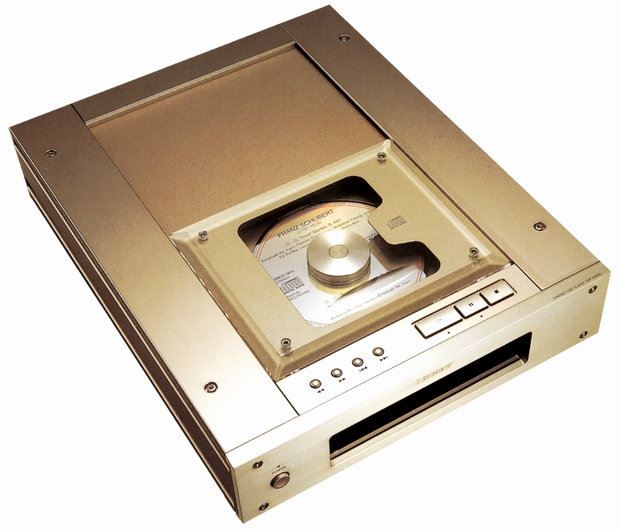
SONY CDP-X3000
¥ 60,000 (released in 1996)
Commentary
A CD player that inherits the design philosophy of CDP-X5000 and introduces newly developed technologies such as variable digital filters.
An optical system fixing mechanism has been adopted for the mechanism, and the optical pickup is fixed to the strong base part and the disk side is moved. This greatly reduces vibration of the pickup, and the current required for servo is limited to relatively slow movement to compensate for distortion and eccentricity of the disk, and the fluctuation of servo current is reduced.
While taking advantage of the optical system fixing method, a top-loading method is adopted to reduce the size. The disc is set by sliding the lid of the top panel by hand and fixed with a stabilizer.
In addition, the mechanism has a unique floating structure inside, and it is mounted directly on the chassis to obtain simplicity and stable drive performance.
The servo circuit uses a high-precision digital servo, and by adjusting the servo amount of the optical pickup for each disc being played, servocontrol that more accurately reflects the disc condition is possible.
The digital filter is equipped with a newly developed variable (V. C.) digital filter.
The cut-off characteristics and phase characteristics of digital filters can be set by equations, and sound quality can be changed by changing these characteristics. Therefore, we have registered multiple equations for newly developed digital filter ICs so that you can select your favorite position according to your audio equipment, room environment, and music.
In addition to the standard position with sharp roll-off characteristics, the CDP-X3000 is equipped with No. 1, 2 and 3 with slow roll-off characteristics. You can choose from a total of four positions.
The Standard and Spline variable digital filters use full feed-forward digital filters.
This digital filter employs a three step coupling of a double-type digital filter, which first generates complementary data at the midpoint between the data obtained from the disk and the data, and then uses the resulting data to create the next complementary data. Conventional digital filters use only the high-order bits by rounding the low-order bits of the calculation results obtained here, but this rounding error causes requantization noise.
The full-feed-forward digital filter realizes an oversampling operation that also reflects low-bit data by performing a full-feed forward (FF) operation that combines the low-bit data with the result of the next stage operation. This eliminates almost all requantization noise in the audible band, greatly improving the quality of low-level signals.
A current pulse D/A converter is used for the D/A converter.
In this method, a stable and clean current source is prepared, and the current pulse is generated by switching using the output of the pulse generator. This eliminates the influence of voltage fluctuations and the influence of voltage noise in the arithmetic circuit, which are problems with conventional pulse D/A converters that use voltage.
It also employs a complimentary service PLM that differentially synthesizes the output of the pulse D/A converter to reduce harmonic distortion.
The chassis adopts a mono-box structure and realizes a structure in which vibration is hardly transmitted by combining high-strength members with screws.
An eccentric insulator is used for the legs.
This insulator is designed with the mounting hole offset from the center, and vibration propagation to the chassis is reduced by mutually canceling external vibration. The position and diameter of the hole are determined through repeated trial production and trial listening. This is particularly effective in attenuating mid - and high-frequency vibration components that affect audibility.
An R core transformer is used for the power supply.
In the R-core transformer, magnetic flux leakage and vibration are greatly reduced by making the iron core a circular doughnut type with no breaks.
Two digital output systems are mounted : optical and coaxial.
The digital output can be turned ON/OFF, and turning it OFF reduces the influence on the analog output.
Equipped with a custom edit function, you can control functions such as peak search, program edit, manual fader and variable fade.
It is equipped with functions such as shuffle play, delete shuffle, 5-mode repeat and index search.
Wireless remote control is included.
Model Rating
| Type | CD Player |
| D/A converter | Current pulse D/A converter |
| Digital filter | Variable digital filter |
| Frequency characteristic | 2 Hz to 20 kHz ± 0.3 dB |
| Dynamic range | 100 dB or more (EIAJ) |
| Total harmonic distortion factor | 0.003% or less (EIAJ) |
| Wow and flutter | Below the measurement limit (± 0.001% W. peak) (EIAJ) |
| Digital output | Light : -18dBm (emission wavelength 660 nm) Coaxial : 0.5Vp-p/75 Ω |
| Analog output | Fixed : 2.5 Vrms |
| Pwer | 100 VAC, 50Hz/60Hz |
| Power consumption | 15W |
| External dimensions | Width 280x Height 90x Depth 400 mm |
| Weight | Approx. 6.0 kg |
| Attachment | Stabilizer Wireless Remote Control RM-DX3000 |
| Position | Cutoff characteristic | Type / Method | Sound impression |
| Sharp roll-off | |||
| Standard | .jpg) |
Conventional Digital Filter / Full feed-forward system |
Wide range Sense of spaciousness |
| Slow roll-off | |||
| No1 Spline |
.jpg) |
Cubic spline function / Full-feed system |
Smooth feeling Sound image localization clear |
| No2 Plain |
.jpg) |
Requantization noiseless / Direct 8 x system |
Fresh sound Strength |
| No3 Analog type |
.jpg) |
7th Butterworth / Direct 8 x system |
An atmospheric warm sound Depth feeling |
.jpg)
.jpg)
.jpg)